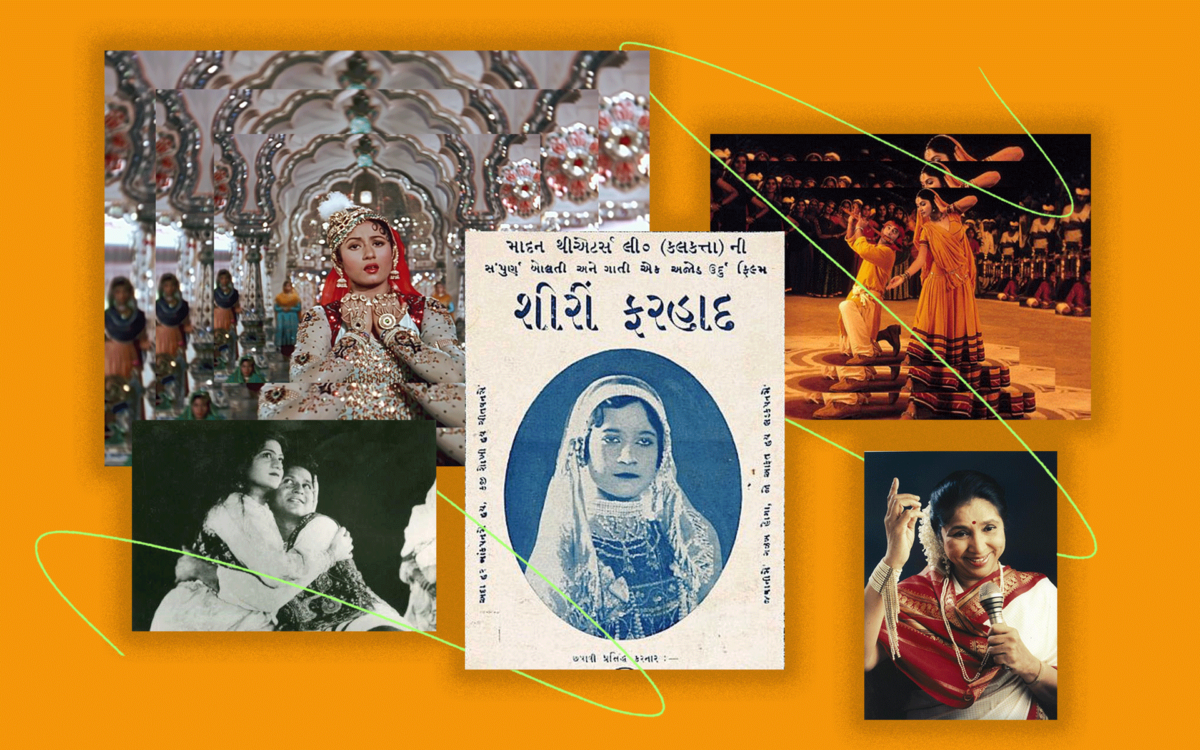Hindi film music, commonly referred to as ‘Bollywood music,’ is one of the most popular forms of music in the world today.
The Indian film industry produces up to 2,000 movies each year—more than double that of Hollywood. Bollywood is the Hindi-language film industry in Mumbai (formerly Bombay), India.
Bollywood music is derived from song-and-dance routines in Hindi films. Due to their enduring popular appeal and cultural impact, Bollywood songs and dances are a characteristic motif of Hindi cinema.
One of the reasons for the popularity of Bollywood songs has been the willingness of composers to adopt and be influenced by various musical forms including Western pop, jazz, rock, and classical music. These songs are generally composed in Hindi, though often the vocabulary and language usage deviate from that of standard Hindi and can include the use of Urdu, Persian, and English words, along with compositions in various Hindi dialects.
The beginnings of Bollywood music (1930s – 1950s)
Bollywood music was born in 1931 with the advent of India’s first sound motion film, Alam Ara by Ardeshir Irani, which featured seven songs. It was during this time that the seeds of the new musical genre were sown. The film was closely followed by Jamshedji Framji Madan’s Shirheen Farhad (1931), which featured 42 song sequences strung together in the manner of an opera.
Between 1931 and 1940, India produced around 930 feature films with an average of ten songs per film. During this period, many of the original actors and actresses sang the songs, similar to Hollywood.
However, during the ’40s and ’50s, the business began to shift away from big motion picture studios to independent producers. Since most actors who could sing would end up working for big motion pictures that paid more than independent producers, this period resulted in the introduction of a new concept called playback singing.
A playback singer, also known as a ghost singer, is a singer whose voice is pre-recorded for use in films, and actors or actresses lip-sync the songs for the camera. Many notable playback singers and major music directors came to prominence during this period, such as Lata Mangeshkar, Hemant Kumar, Asha Bhosle, C. Ramchandra, and S. D. Burman (known as the “Nightingale of India,” Mangeshkar, who recently passed away in February 2022, had a career spanning eight decades as a playback singer).
The film equipment used in this period was not high quality, making playback singing a necessity. In fact, the noise from the film equipment was so loud that all the dialogue had to be dubbed again as well. It was only in 2001, with Lagaan, that the first synchronous sound movie was produced.
Unlike the United States or United Kingdom’s music industries, the Indian music industry has not been a separate industry with a traditional growth pattern. Rather, it has emerged as a byproduct of Bollywood and has always been a subsidiary of the Indian film industry.
Access the world’s best sample library and connected creator tools for only $0.99.
Two different eras
1. Studios
From 1935 to 1950, like Hollywood, Bollywood was run by film studios. Prabhat Studio was the first Hindi film studio established in 1929, followed by B N Sircar’s New Studio in 1931, Rajkamal Kalamandir in 1942, Mehboob Studio in 1943, RK Studios by Raj Kapoor in 1948, and Navketan Films by Dev Anand in 1949. This period is also referred to as the “Golden Era of Bollywood” because it gave rise to some of the most iconic movies, actors, and musicians of all time. And studios provided a platform for their film directors, actors, and musicians to be famous.
Eventually, film stars’ salaries were skyrocketing to the point where they became too expensive, and most studios ultimately went out of business.
2. Music Directors
As Bollywood moved away from studios running the industry, independent movie directors began to gain prominence. From 1950 – 1998, famous film directors produced their own films and paved the way for independent music directors, who became crucial to the success of a film in terms of name attachment.
In Bollywood films, a music director often has a much broader role encompassing both composing music specifically for the film and securing additional licensed music. Hence, a Bollywood music director is usually also the composer and the music producer of the film.
One of the most famous music directors of this era was R. D. Burman—also known as the “King of Bollywood Music”—who worked extensively on and scored approximately 331 films from the ’60s to the ’90s.
The intertwined history of Bollywood movies and music
As a result of not being a separate industry, the Indian music industry has not been given the required attention by the Indian government. In fact, “India’s recorded music industry generated just U.S. $0.09 per capita in trade revenues in 2016, making it the most poorly monetized music market currently being tracked,” according to Ed Peto’s article “Interim Economy: An Introduction to India’s Digital Music Industry.” This is because the government has yet to build proper systems around licensing, copyright, publishing, etc. that cater to artists, music composers, songwriters, and music producers outside of the film industry.
Major record labels like Sony Music Entertainment and Universal Music Group do have an Indian division. However, the relationship between an artist and a record label is almost always a work-for-hire contract, with a lack of differentiation between labels and publishers. Most musicians are hired by film productions and the label mainly caters to the film industry (because that’s where the money comes from).
A history of complicated copyright practices
In the ’70s, ’80s, and most of the ’90s, musicians and artists were heavily dependent on movies, music labels, and production houses for opportunities in the Indian music industry. In most cases, it was the producer or the production house that benefitted most from the success of the film music. While due credits were given to the music composer, lyricists, and singers, few financial benefits were extended to them.
There have been years of mystery surrounding this situation—however, it has recently come to the forefront. Royalty checks for music creators are “often accompanied just by a covering letter, with no indication of how they have been calculated, and from which sources,” according to “India music trends: Transparency, independent artists, and more.” Therefore, the relationship between the government and private corporations in the Indian music industry has been extremely complicated.
For a more in-depth analysis of the copyright laws in India including recent developments, check out this article.
The rise of music streaming services in India
The broad consumption of music in India has also been notably different from the music industries in other parts of the world. With a population of 1.38 billion, India has been the sleeping giant of the global music industry. The music streaming market has been rapidly growing in recent years, mainly because of the implementation of 4G, lower data costs, and an increasing number of smartphone users. The top digital music service providers that have emerged in the past four years are JioSaavn, Gaana, Wynk Music, Spotify, and Google Play Music.
Due to the pandemic, in the first half of 2020, streaming services saw an increase in listeners by 40%. This resulted in music streaming services owning 85.1% of the Indian music business market share over that year.
Even though the majority of Hindi music consumed on streaming services is Bollywood music, they have provided the opportunity for non-film music to break the shackles of cinema.
Looking ahead
The Indian music market is undeniably exciting and has a fantastic potential for a bright future. In the coming years, it’s likely that we’ll see significant growth in the Indian music industry as its own business, both within India and on a global scale.
Incorporate Bollywood-inspired sounds into your own productions:
November 15, 2023

.svg)
.svg)




